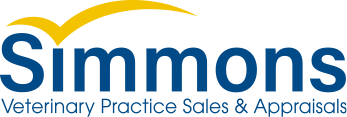Simmons & Associates MidSouth – Wilson McManus II, DVM, CVPM & Kris Smith, CVPM |
Do you feel you have a successful, busy veterinary practice, but you consistently end up with little or no profit at the end of each month? Have you recently had a practice valuation and were shocked that you don’t have anything to sell? You are not alone, as many practices face these issues.
Read on for practical applications to increase your veterinary practice’s profit and value. Our improvement suggestions come from years of successful practice management experience assisting and coaching our clients to better control their drugs and supply expenses.
Products and Goods Cost
Traditionally, small animal practices have a total cost of the product (COPS), cost of goods sold (COGS), or simply inventory and supplies in the 20-22% range of total practice revenue. Large and mixed animal practices tend to run higher.
Say No to Drug Deals
If you find your COGS expenses are running higher than 20-22%, ask yourself, are you artificially inflating your inventory costs by making deals and purchasing large quantities of products on a “buy-in” or “drug deal” to receive delayed billing, bundles of cashback or, even better, a free cooler. Practice owners and managers know they will eventually use the product, so why not get a discount or, better yet, something free. Inducements are designed to make you move their product onto your shelves. If it is on your shelf, it is off of theirs.
Buy What You Need
We recommend saying no to these types of drug buy-in deals and instead suggest that no matter how good the deal, you only buy what you can use in the next week. These too-good-to-be-true deals sound sweet, but they are bitter to your profits. They can adversely affect your ability to manage profit and ultimately the lifeblood of every business — your weekly and monthly cash flow.
Inventory Management
Inventory management is so much easier to manage today. With next-day or two-day delivery available, we recommend you only order the inventory and product amounts you would reasonably expect to use in the next seven to ten days.
Set a Budget
If you order weekly, use last week’s sales — the previous seven days of gross income — as a guide and set a budget of no more than 10% or less of the previous week’s gross revenue or sales for inventory replenishment. Utilizing the inventory module in your software is the best way to quickly determine the inventory products you need to order for the coming week. By establishing your reorder points or the minimum number of item(s) you need to keep in the hospital weekly, you will quickly gain control of your practices’ inventory.
Create a Baseline Reorder Point
This process takes some time and effort to get started, but it is well worth the effort. If you can’t do it all at once, start with expensive items such as heartworm prevention, flea and tick preventatives, and name-brand arthritis medications. Then move onto other categories each week as you develop your reorder points. Evaluate your practice management software transaction details report for the previous month to determine how many units you sold of each brand and size in the previous month and divide that number by 3. This number becomes your baseline reorder point — ideally 1 week plus a small cushion. On your weekly inventory ordering day, your inventory manager can print your inventory re-order report and verify it against what’s on the shelf. If you are below your baseline reorder point, order up to that number. If you are over that point, you will not need to order any product this week.
Prevent Inventory Shrinkage
When you order large product quantities, the product may mysteriously “grow legs and walks off.” The industry term for this is inventory shrinkage. Many owners think this is impossible and does not happen in their practices, but it does — more often than they think. Quite often, the perception is that there is so much product there that no one will miss one or two packs of flea or tick control or heartworm preventative. But those packs can easily cost $50-$100, not to mention you lose the profit on a future client sale. By ordering only the inventory you need for the week, you can monitor your inventory counts more effectively, especially on your higher-cost items, because it is more obvious when shrinkage or theft occurs.
Track Inventory
Inventory tracking requires regular counts and should take place at least quarterly, with corresponding updates or adjustments to correct balances in the inventory module of your practice management software and financial statements. We recommend counting expensive medications weekly to send the signal that these high-cost medications are being monitored regularly.
Calculate Inventory Turns
An effective way to double-check if you’re controlling inventory costs is to calculate your “inventory turns” per month. We have found that well-managed practices will have inventory turns of 1 time per month or 12 or more times inventory turns annually. To calculate this number, divide your cost of sales (COGS) from the previous year by your total year-end inventory figure from your balance sheet. By comparing your current inventory turns to your end-of-year number, you can track your continued improvement.
Adjust Costs
Controlling inventory expenses is only a part of the solution, and regularly making adequate markups and inflationary cost adjustments is equally important. We often see inadequate markups, especially in rural practices, which result from competing with the internet or with the local feed store. Practices should also evaluate pharmacy and outside laboratory service prices to ensure margins cover costs and compensate the veterinarian for the sale.
Lowering product markup causes inventory costs (COGS) as a percentage of revenue to rise well above 30% of revenue. Product sales may be healthy, but if the practice is stocking and selling the products at too low of a margin, it can adversely affect the practice’s profit and value. The results are an increase in practice gross revenue but a decrease in profit and subsequent practice value. Remember, you can’t compete with mass merchandisers on prices. It’s best to offer competitive pricing, convenience, manufacturer’s warranties, rebates, and excellent service to maintain the practice’s market share.
Chart Your Revenue and Expenses
We highly recommend implementing and using the AAHA/VMG Chart of accounts for recording revenues, drugs and supplies, and other expenses as a way to monitor your practice’s overall revenue and expenses.
Simmons Helps Protect Your Practice Value
At Simmons Veterinary Practice Sales and Appraisals, we know it is difficult to wear so many hats in a veterinary practice — Chief of Staff, Practice Manager, Human Resource Manager, to name just a few — and still practice veterinary medicine. That’s why this guidance is not intended to be a one-size-fits-all solution but provides general principles to help you develop your own systems to manage your costs and increase your hospital’s overall profit.
We are passionate about helping you identify and make necessary changes to make your practice more profitable and valuable over time because we want to give you the tools you need to succeed and grow your practice. Contact your area’s Simmons representative for more information on a practice valuation for management, especially if you plan on exiting your practice in the foreseeable future.



